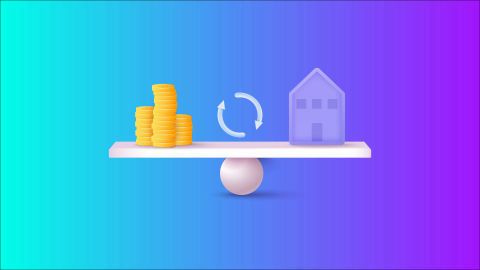The Income Tax Act, 1961 governs the levy and collection of income tax in India. A closer look at this Act will show you that income tax is fairly simple. The Act recognises five heads of income under which earnings are taxed. The rates of income tax depend on the level of a taxpayer’s total taxable income.
The Income Tax Act also has some beneficial provisions that help you save taxes and reduce your tax burden. These provisions are tax deductions available on specified investments and expenses. You can claim these deductions from your total income, reducing your taxable income – and, effectively, your overall tax liability.
Income Tax Slab Rates Under the Old and New Tax Regimes
To understand tax benefits available in the form of deductions as per the Income Tax Act, let us first look at the different tax rates as per the old and new tax regimes.
Income Tax Rates for Resident Taxpayers Under the Old Tax Regime
Income tax slab |
Income tax rates for taxpayers aged below 60 years |
Income tax rates for taxpayers aged 60 years or more, but below 80 years |
Income tax rates for taxpayers aged 80 years or more |
Up to Rs. 2,50,000 |
Nil |
Nil |
Nil |
Rs. 2,50,001 to Rs. 3,00,000 |
5% |
Nil |
Nil |
Rs. 3,00,001 to Rs. 5,00,000 |
5% |
5% |
Nil |
Rs. 5,00,001 to Rs. 10,00,000 |
20% |
20% |
20% |
Above Rs. 10,00,000 |
30% |
30% |
30% |
Income tax rates for resident taxpayers under the new tax regime
Income Tax Slab |
Income Tax Rate |
Up to Rs. 2,50,000 |
Nil |
Rs. 2,50,001 to Rs. 5,00,000 |
5% |
Rs. 5,00,001 to Rs. 7,50,000 |
10% |
Rs. 7,50,001 to Rs. 10,00,000 |
15% |
Rs. 10,00,001 to Rs. 12,50,000 |
20% |
Rs. 12,50,001 to Rs. 15,00,000 |
25% |
Above Rs. 15,00,000 |
30% |
Understanding income tax deductions
Once you compute your total earnings under the five different heads of income, you can claim applicable tax deductions. These deductions are offered on various eligible investments and expenses such as life insurance premiums, health insurance premiums, investments in PPF and more.
You can deduct the applicable amounts from your total income to determine your taxable income. Then, based on the income tax rate applicable for the slab, you need to pay taxes to the government.
The Most Important Tax Deductions You Can Claim as per the Income Tax Act, 1961
Most of the deductions available to taxpayers are contained in Chapter VIA of the Income Tax Act. In addition to this, other sections contain tax benefits for specific expenses. Check out the most important income tax deductions available below.
Section of the Income Tax Act |
Particulars of the tax deduction |
Maximum deduction allowed |
Tax regime applicable |
24(b) |
Interest on home loan for self-occupied or let-out properties, taken for the purpose of construction, purchase, repair, or reconstruction |
|
The deduction for interest paid on home loans for self-occupied properties is not available in the new tax regime |
80C |
Investments made in various schemes like Public Provident Fund (PPF), National Savings Certificate (NSC) etc., as well as different expenses like life insurance premium, home loan principal repayment, tuition fees, etc. |
Total of Rs. 1,50,000 (including deductions claimed u/s 80CCC and 80CCD(1)) |
Available only in the old tax regime |
80CCC |
Contribution towards any annuity plan offered by LIC or any other pension scheme |
Total of Rs. 1,50,000 (including deductions claimed u/s 80C and 80CCD(1)) |
Available only in the old tax regime |
80CCD(1) |
Any investments in specified pension schemes of the central government |
Total of Rs. 1,50,000 (including deductions claimed u/s 80C and 80CCC) |
Available only in the old tax regime |
80CCD(1B) |
Payments made to any pension schemes of the central government, excluding those covered u/s 80CCD(1) |
Rs. 50,000 |
Available only in the old tax regime |
80CCD(2) |
Employer’s contribution to a pension scheme of the central government |
14% of salary if the employer is the central government, and 10% of the salary if the employer is a state government, a Public Sector Undertaking (PSU) or other entities |
Available in the old and new tax regimes |
80D |
Premium payments made for health insurance (taken for self, spouse, dependent children, or parents) and expenses incurred for preventive health checkups |
Rs. 25,000 (or Rs. 50,000 if the policyholder is a senior citizen) |
Available only in the old tax regime |
80DD |
Expenses incurred for maintenance and medical treatment of a dependent person who is disabled |
Rs. 75,000 (or, in case of severe disability, Rs. 1,25,000) |
Available only in the old tax regime |
80DDB |
Expenses incurred for medical treatment of specified diseases for self or any dependant |
Rs. 40,000 (or, in case of senior citizens, Rs. 1,00,000) |
Available only in the old tax regime |
80E |
Interest repayments made on education loans taken for higher education of self or relatives |
Total interest paid during the financial year |
Available only in the old tax regime |
80EE |
Interest on home loans below Rs. 35 lakh, sanctioned in FY 2016-17, for the purchase of a house property whose value does not exceed Rs. 50 lakh |
Rs. 50,000 |
Available only in the old tax regime |
80G |
Donations made to specified charitable funds and schemes |
100% or 50% of the donation made |
Available only in the old tax regime |
80TTA |
Interest received on savings bank accounts |
Rs. 10,000 |
Available only in the old tax regime |
The most important takeaway from the above pointers is the distinction between the old and the new tax regimes. While the old regime allows for all the existing tax deductions, the tax benefits in the new regime are significantly limited.
If you already have a lot of deductible investments and expenses, opting for the old tax regime may be more suitable. On the other hand, if you do not have many deductible items in your portfolio, the new tax regime can give you concessional tax rates.








